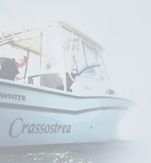


Department of Biology
University of Maryland
College Park, Maryland 20742
301-405-7684
Chesapeake Biological Laboratory
P.O. Box 38 / One Williams Street
Solomons, MD 20688
410-326-7259
|
|
 |
        |
 |
COOPERATIVE REGIONAL OYSTER SELECTIVE BREEDING (CROSBreed) PROJECT: COMPREHENSIVE STRATEGY FOR GENETIC REHABILITATION AND CONSERVATION OF OYSTERS
- Standish K. Allen, Jr., Kimberly S. Reece, Eugene M. Burreson, Mark W. Luckenbach, Mark D. Camara
Virginica Institute of Marine Science, College of William and Mary
- Gregory A. DeBrosse, Ximing Guo
Haskin Shellfish Research Laboratory, Rutgers University
- Matt Hare, Kennedy T. Paynter, Don W. Meritt
Department of Biology, Horn Point Environmental Laboratory, University of Maryland
- Patrick M. Gaffney
College of Marine Studies, University of Delaware
The Cooperative Regional Oyster Selective Breeding (CROSBreed = the acronym for the consortium) project was initiated in 1995 when a selection program for disease resistant strains of oysters (Crassostrea virginica), developed at Rutgers University, was adopted by a regional consortium including New Jersey, Delaware, Maryland and Virginia. Funding from 1995-1998 initiated the testing of CROSBreed oysters (XB = the abbreviation for the oyster strain). A second round of funding in 1999 supported continued development of XB lines by CROSBreed and trial deployments of XB oysters on oyster bars in Maryland and restored reefs in Virginia. Also funded in the 1999 ODRP cycle (as a separate proposal) was development of molecular markers in support of oyster genome mapping. Here we propose a comprehensive strategy for the continued development and exploitation of disease resistant strains not just XB, but several others included and their widespread dissemination for oyster restoration and aquaculture. In essence, we seek support for a Bay-wide approach for genetically rehabilitating oysters in the Chesapeake, and possibly the mid-Atlantic. There are three central components to this approach. 1) The backbone of CROSBreed continues to be development and testing of disease resistant varieties. 2) Development of molecular markers should be completed with two more years of funding. These markers are central to a) accelerated breeding by marker assisted selection and b) oyster restoration by tracing spatial/ temporal recruitment and introgression patterns. 3) Deployment of selectively bred stocks (that are genetically marked) begins an ambitious period of executing a strategy of genetic rehabilitation of oyster stocks at test sites in the Chesapeake Bay, perhaps serving as a model for threatened populations elsewhere.
The CROSBreed project has generated numerous ancillary benefits. XB stocks have been released to hatcheries with subsequent distribution of seed to oyster growers for public programs, private oyster gardening, and oyster repletion. The distribution of XB brood stock has helped to increase awareness of the genetic origins of oyster stocks (natural populations) and strains (artificial populations). XB oysters have become a favorite template for other research projects, especially ODRP ones studying disease mechanisms. Probably the most profound effect of the CROSBreed project is the effect it has had on drawing a group of investigators together into a regional, mission oriented approach. Thus, CROSBreed now is less about the strain of oyster itself than about the regional collaboration to exploit XB and other resistant strains for aquaculture and restoration. The coalescence of investigators from the mid-Atlantic has been formalized through the formation of the Mid-Atlantic Aquaculture Genetics and Breeding Technology Consortium, a joint MOU among New Jersey, Maryland and Virginia, and soon to include Delaware. The Mid-Atlantic Consortium is also seeking other forms of Federal support to further enhance our collaborations in shellfish genetics and breeding.
The PIs listed on this proposal now comprise a working group that has formulated a unified strategy for improvement and application of disease resistant strains to the oyster disease problems. Our goal is to refine and execute this comprehensive strategy for aquaculture and restoration. Aquaculture is not addressed directly in this proposal. We focus here on disease resistant strains for restoration. For restoration, the issues are complex and warrant a focussed approach from many labs (discussions below). The specific objectives of this proposal are as follows:
- Evaluate the phenotypic performance of XB strains in outplantings in both Maryland and Virginia, especially with regard to the long-term persistence of the population relative to wild stocks.
- Continue improvements in disease resistance in XB strains as well as several other lines that show promise by artificial selection.
- Complete marker development using both microsatellite and single nucleotide polymorphism markers, and verify them with progeny testing of pedigreed families.
- Begin "deployment" of genetic markers by 1) characterizing wild populations in candidate sites for genetic rehabilitation and 2) creating and characterizing hatchery seed for deployment at sites identified in 1).
|
|
 |
|
